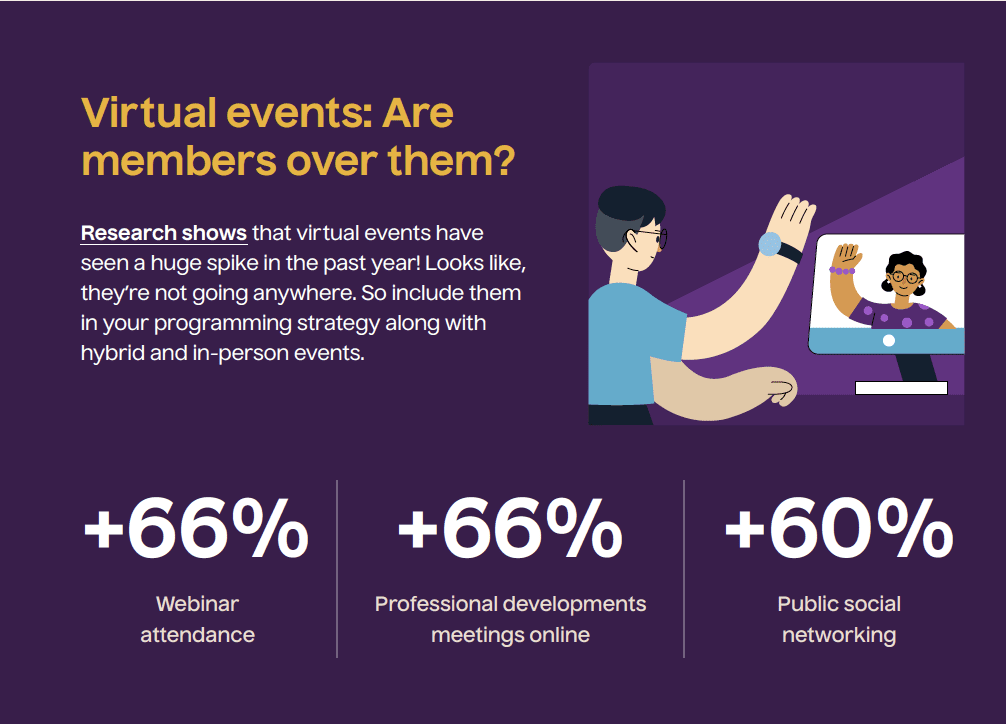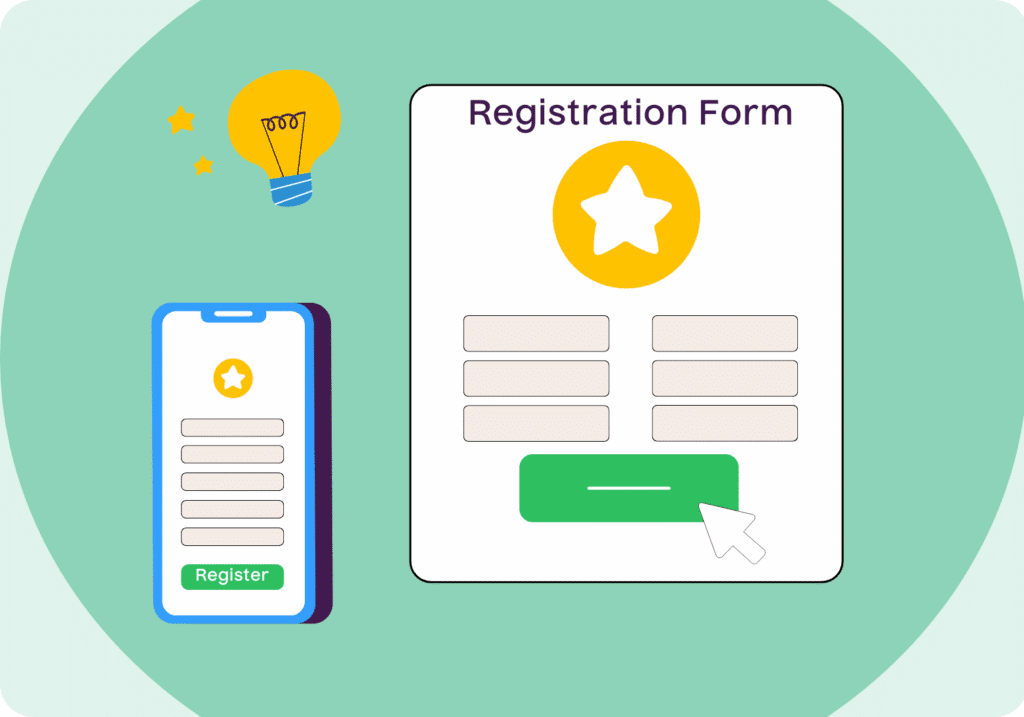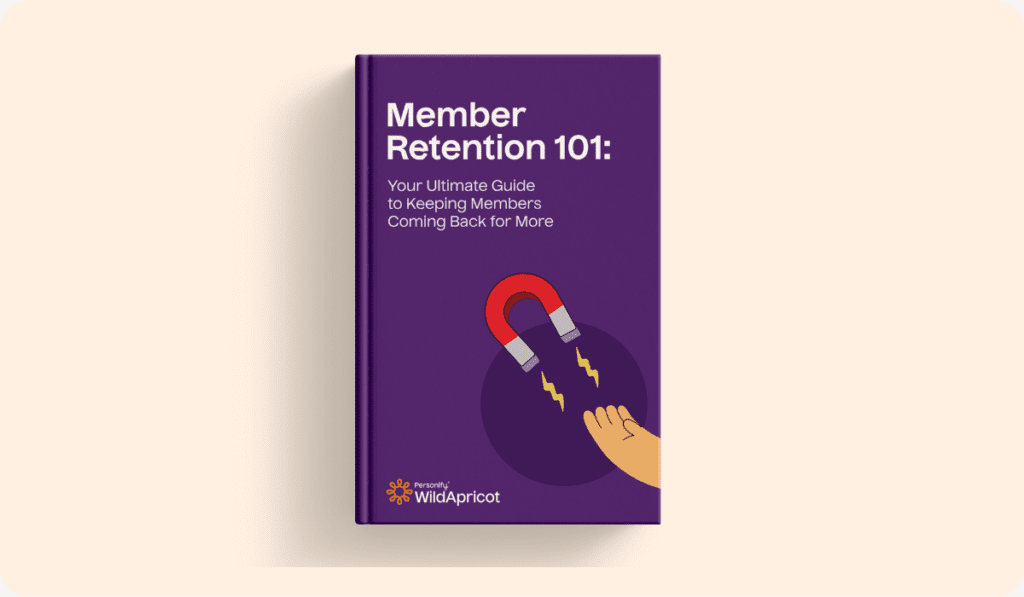Since the COVID-19 pandemic began in 2020, we’ve seen a rise in virtual events in different industries across the world. While in-person events have been coming back, you shouldn’t abandon the virtual route completely!
Let’s explore the benefits of running virtual events, brainstorm some fresh ideas and nail how to plan them stress-free. Plus, we have a list of our 9 favorite virtual event platforms.
Here we go!
What are virtual events?
Virtual events are exactly what they sound like—events that are run virtually! Rather than going to an in-person venue for an event, attendees participate from their computers at home.
How does a virtual event work?
Typically, a virtual event is hosted on a virtual event platform. Participants register in advance, receive the necessary links and then attend! The structure will look different for individual virtual event types, but the set-up is pretty consistent.
Benefits of virtual events
While virtual events can feel intimidating for people who have not run them before, there are actually tons of benefits!
- Cost-effective & better ROI: 84% of organizations who had already run a virtual event in 2020 reported that they spent less money on virtual events than in-person events. With reduced expenses on things like venue and catering, there’s a much higher ROI!
- Wider audience reach: Virtual events can reach attendees from all over the world, especially if you optimize them for your target timezones. In fact, the best time to run a webinar is 11 a.m. PST (2 p.m. EST) as it avoids most conflicts on the U.S. coasts.
- Accessible & flexible to all: Whether it be because of childcare, disabilities or something else, not everyone who wants to attend an event will be able to. Hosting virtual events is a great way to keep things accessible.
- Better data collection: Curious about how many registrations actually attended your event? If you’re holding it virtually, you can quite literally count them!
- Reduced travel expenses: Travel costs pile up fast for your team and your guest speakers, which eats into that ROI we mentioned. Virtual events remove that burden!
- Improved attendance: Our above point applies to your guests as well—without a travel requirement in place, you’ll see a whole lot more attendees.
- Enhanced engagement: We can’t overstate the power of virtual event engagement! Some people get stage fright at in person events, and being behind a laptop might make people more comfortable engaging with interactive virtual features.
And for fundraising…
- Increased donor participation: As we said above, interactive virtual features are a great way to get people involved—which can turn supporters into donors. In fact, successful revenue generators were 46% more likely to promote a donation page throughout their virtual event.
- Easier donation tracking: Events like virtual fundraisers give you live data on how people are interacting. At any time, you can measure virtual event statistics, such as what activities aligned with the most donations.
- More efficient donation processing: At an in-person event, you need to figure out how to accept donations in the moment. Virtually? It’s as simple as sending a link! Plus you’ll have support staff available on-demand for any questions donors might have.

15 Virtual Event Ideas
Now that you’ve seen all the benefits of running virtual events, you might be looking for some creative virtual event ideas.
Here are 15 different virtual event types, and how to make them work for you:
Webinars
Running a webinar allows you to bring a guest speaker’s special knowledge directly to your attendees’ living room! Give your speakers anywhere from 60 to 90 minutes to share their presentation, and be sure to include a Q&A at the end.
Because these events are generally educational, it’s also beneficial to offer a recording of the webinar after the fact! You can even include the recording as exclusive content on your membership website.
Online Learning and Certification Programs
Many people are hungry for educational opportunities! If you’re running something like an association, special certifications are an even more valuable offering.
Virtual events are amazing because they make this continuing education more accessible. Instead of attending a full-time course, people can engage at their pace regardless of things like work schedules or childcare obligations.
Online Workshops
Where webinars are great for people who want to sit back and listen, virtual workshops give attendees room to really engage! For example, if you’re running a literary organization, hosting a virtual writing workshop with an established writer gives people live mentorship and the opportunity to produce something special.
Don’t forget to incorporate multiple learning styles into your workshops! Different guests will want to engage in different ways, and the more opportunity you provide, the better response you will have.
Virtual Roundtables and Panels
Is there anything better than listening to a bunch of smart people talk? In the age of podcasts, it might not be surprising that so many people think this way! Hosting virtual round tables and panels brings the conversation into your guests’ living rooms.
Online Mentorship Programs
Never underestimate the value of mentorship—this is especially true if you’re running something like a professional organization. People are constantly searching for ways to get ahead in their industry, and working with experienced mentors adds a personal touch.
This is one of the best virtual event types because it allows you to connect people from all over the world! Take advantage of the opportunity to make connections you may not have been able to in person.
Virtual Conferences
Conferences are staple events in any industry! They offer networking opportunities, educational resources and the scoop on upcoming industry trends. One major impact of COVID-19 on virtual events was exploring how to recreate the bustling conference feeling and people’s homes.
Since 2020, we’ve learned a lot more about running virtual conferences. While they serve a similar purpose to in-person conferences, they ultimately have to function differently—which isn’t a bad thing!
The idea of a busy weekend at a hotel is exciting, but keep in mind how virtual conferences can save costs, reach more people and simplify networking.
Virtual Trade Shows
Taking your trade shows online opens up the opportunity for things like virtual product launches and reaching new partners globally. If you want to demonstrate a new product or idea, a virtual trade show lets you pre-record a video, which can reduce unexpected surprises day-of!
Virtual Fundraisers
Virtual fundraisers have TONS of potential to bring in massive donations! Where some people might be too tired to attend a fundraising event in person, anyone can tune in to your virtual fundraiser for ten minutes. That’s long enough to see what you’re all about and decide to make a donation—and then share it on social media.
Just imagine if getting people out to a physical event was as simple as summoning them with a link!
Virtual Auctions
As you’re brainstorming different auction ideas, don’t forget that you can hold the event without a physical auction hall! Like we said with other events, keeping things virtual gives you a wider reach—you can even share information about the prizes online before the event.
Virtual Galas
Galas are one of the hardest events to recreate online, but that doesn’t mean it’s impossible. encouraging people to do a “red carpet” on social media (complete with your event’s hashtag, of course!) can bring some formality to your virtual event.
Hosting virtual happy hours is also a whole lot of fun. Consider pairing with a local brewery or winery, or inviting a mixologist to give an online tutorial for guests!
It’s true that it won’t be the same a stepping into a ballroom, but it will also be a whole lot less expensive.
Virtual Award Ceremonies
Everyone is happy to be recognized, and holding a virtual award ceremony brings some joy into people’s homes. Brainstorm the kinds of awards you would like to give out in your industry, and invite people to virtually celebrate those who deserve it most.
Virtual Membership Meetings
According to the Virtual Events Research Report for Membership Organizations, 91% of respondents chose “keeping members connected” as a primary goal of virtual events. And the great news is, virtual membership meetings really work!
The easier you make it for people to attend your meetings, the more likely they are to participate. And what’s easier than tuning in from home?
Virtual Committee & Board Meetings
Both your board of directors and your committees work hard to keep your organization thriving. Hosting at least some of your required meetings online will make it easier to fit this time into everyone’s schedule. Plus, you can have a recording on hand for your secretary to review in case there’s confusion about the meeting minutes.
If you’re looking for a way to strengthen everyone’s connections, you can also incorporate informal virtual team-building activities. After all, it’s essential to work as a team!
Virtual Networking
Networking events are hugely appealing to members of organizations such as nonprofits and associations. Instead of shaking hands in person and exchanging business cards, virtual networking events help people share their contact information with the click of a button.
With the popularity of social media, hosting networking events virtually is a natural way to go!
Virtual Job Fairs
One major impact of COVID-19 on virtual events was felt by job hunters. Instead of attending in-person events, they had to find ways to connect over the computer. By hosting a virtual job fair, your organization can connect recruiters directly to applicants.
On Charging Ticket Prices for Virtual Events
Organizations who raised the same amount of money or more than they expected to at their virtual event compared to an in-person event were more likely to charge admission and find sponsors for their virtual events. If you’re looking for a price point, research what similar organizations or competitors are charging for similar events
Don’t let yourself doubt the value of your virtual offerings! To quote Joy Duling from The Joy of Membership said, “As organizations gain more experience with virtual events, I believe they’ll become more confident about the value they’re able to deliver virtually, and bringing in revenue from those events will no longer be an issue.”
How to Plan a Virtual Event
Now that we’ve reviewed the benefits or virtual events and suggested a bunch of ideas, let’s explore how to start planning!
1. Decide on your event
First, ask yourself these three questions:
- What is your goal? Are you looking to bring in new members, make money, raise awareness for a cause? Be sure to pick your goal nice and early.
- Who is your audience? Unfortunately, “everyone” isn’t a great answer when it comes to measuring success! Brainstorm your target attendee, and work towards their wants.
- What resources do you need? What virtual event platform or software would best serve you? Are there any key players you need to run this event?
To bring up more wisdom from Joy:
“The challenge in creating virtual events that members want to attend really isn’t that different from creating value in any aspect of your membership.
You need to know 3 things:
- What the outcome is that the member wants;
- How to achieve the outcome with the tools that you are using;
- Whether the outcome is important enough to the member to be placed ahead of other priorities.
If any of those three things are misaligned, you’re likely to have trouble – not just with virtual events, but with anything that you are currently offering to members or proposing to offer to members.”
2. Choose the Right Platform
Choosing the right virtual event platform is a must-do! There are a lot of different options out there, and we’ll explore some of the top contenders further down in the article.
No matter what, be sure your pick includes:
- A user-friendly interface that makes it easy for attendees to engage.
- Customization options to support your branding.
- Accessibility features such as live captioning to support disabled participants.
- Integrations to seamlessly incorporate your event onto your website.
- Security measures to protect speakers and attendees from things like “zoom-bombing.”
- Interactive & engagement features to keep your attendees active during the event.
- Analytics and reporting so you can measure your success.
- Cost-effectiveness, because your event shouldn’t cost you money.
3. Plan the Event
A lot goes into event planning for in-person events, but going the virtual route actually simplifies things quite a bit!
You can plan your event in these steps:
- Create the agenda. What do you want to happen during your event?
- Prepare speakers and presenters. Who do you want to invite to speak?
- Test equipment and technology. Make sure all of your virtual event software is up and running! Holding a tech rehearsal is always a great idea.
4. Marketing the Event
Virtual event marketing is the key to bringing in a fresh batch of attendees.
You can successfully market your event in three simple steps:
- Creating a marketing plan that sets your goals early and gives you the tools to execute them successfully.
- Promoting the event through multiple platforms. 89% of event planners use social media to engage people before the event and 76% of marketers say that email is the single most effective way to drive registrations.
- Report on your success. The information you gather will inform your strategy for future events (and potentially give you the go ahead for a heftier marketing budget!)
5. Engaging with Attendees
Did you know that 49% of marketers say that audience engagement is the biggest contributing factor to having a successful event?
Here are a few ways to actively engage attendees:
- Offer interactive features. Nancy Settle-Murphy, President and Principal Consultant at Guided Insights suggests you “include some kind of interaction at least every 5-7 minutes, whether it’s verbal, a quick poll, chat, hand-up, thumbs-up, etc.” This will reduce the risk of people’s attention drifting!
- Create networking opportunities that form meaningful connections between attendees.
- Provide post-event follow-up to establish lasting relationships with guests. You might even turn them into members!
- Say thanks—after all, everyone likes to feel appreciated.
- Collect feedback & data on how your event was received. All information is good information, and will shape how future events play out.
- Share content. Whether it be in paper newsletters or across social media, remind people how much they enjoyed your event.
Best Virtual Event Platforms
If you’re looking to make running events online a breeze, then it’s essential to find the right software! 89% of businesses using event technology save approximately 200 hours per year, and 20% of businesses see 360 hours or more saved per year.
Convinced yet? Let’s look at your options for virtual event platforms.
9 Popular Virtual Event Software Options
There’s no denying that the internet is full of virtual event software options. That’s why we’ve narrowed it down to our top 9 picks (plus a few more free ones!).
Zoom
Zoom is a cloud-based video conferencing solution that supports wireless media sharing, video system interoperability, screen sharing and more for businesses and individuals.
Price: Free option, then paid plans start at $20/month.
Highlights:
- Cloud and local recording with transcripts
- Multi-user annotation capabilities via screen share
- Customizable backgrounds
GoTo Webinar
GoTo Webinar is a virtual event software designed specifically for webinars, powering millions of them each year.
Price: $59/month.
Highlights:
- Co-presenter capabilities
- Option to call in via phone
- Detailed and insightful analytics
WebEx
Built for hybrid work, WebEx puts calling, meetings, messaging, webinars, event management, polling and more into one unified platform.
Price: Free option for up to 100 guests, then starts at $13.50/month.
Highlights:
- Reduce disruptions with background noise removal and voice enhancement
- Animated emojis and gesture recognition
- Next-gen dynamic polling and Q&A by Slido
Microsoft Teams
Microsoft Teams is an enterprise-grade messaging application that is a collaboration hub for teams, available on iOS, Android and Windows 10 operating systems.
Price: Free option, and then paid plans range from $5/month to $25/month.
Highlights:
- Online voice transmission
- Contact management
- Even business plans are very affordable
Google Meet
Google Meet is a free communication solution that works in sync with the other Google applications and allows you to present, collaborate and live stream meetings to 100,000 viewers at one time.
Price: Free option, then paid plans starting at $5/month.
Highlights:
- Call recording option
- Alerts and notifications
- Comes as a Chrome extension to use across devices
BlueJeans
BlueJeans is a meetings platform that brings video, audio and web conferencing together with the collaboration tools people use every day. It’s the first cloud service to connect desktops, mobile devices and room systems in one video meeting.
Price: Free option, then paid virtual meeting plans start at $15/month.
Highlights:
- Dolby voice with spatial audio for noise reduction
- HD video supported by AI solutions
- Options for meetings, webinars, telehealth and more
StreamYard
StreamYard is a professional live streaming and recording studio built into your browser, capable of streaming to Facebook, Youtube, LinkedIn and other platforms.
Price: Free option, and then paid plans start at $20/month.
Highlights:
- Audience engagement tools
- Moderation capabilities
- Livestream production with multiple camera feeds
Youtube
Youtube is the world’s most popular video hosting platform that helps businesses upload, monetize videos, stream live videos and more.
Price: Free
Highlights:
- Time stamps
- Audio and video file upload
- Text overlay and automatic captioning
Eventbrite
Eventbrite is the world’s largest event ticketing and marketing platform helping event organizers create, manage, and promote events.
Price: No fees for free events. Then 3.5% + CA$1.29 service fee & 2.9% payment processing Fee. All fees are paid by ticket buyers unless you choose to cover them.
Highlights:
- Easy ticketing and registration
- Built in links for virtual events
- Built in marketing tools
6 Free Virtual Event Software Options
Looking for a virtual event platform that won’t break the bank? As you saw above, there are quite a few options available, but these are some of the perks of our favorites.
- Zoom offers a free version for meetings up to 40 minutes with up to 100 participants.
- Google Meet allows up to 100 participants for up to 60 minutes per meeting in the free version.
- Microsoft Teams offers a free version with chat, video calls and file sharing for up to 300 users.
- Skype allows up to 50 people to join a video call for free.
- Jitsi is an open-source video conferencing software that allows unlimited users and meetings.
- Discord is a free voice, video and text chat app designed for gamers but can be used for virtual events.
- StreamYard allows users to livestream to various social media platforms for free.
Membership Management Software to Pair
When you run successful virtual events, you’re sure to bring in new members! But once you have a fresh membership base, it’s important to nurture those relationships. That’s where membership management software comes in!
WildApricot was voted #1 membership management software for 6 years in a row—and for good reason.
This software comes with:
- Event management tools
- An interactive website builder
- A built-in payment processor
- A membership database
- Integrations for software like WordPress
- A mobile app
Sign up for your 60-day free trial today and see how WildApricot can make the most of your virtual events!
Increasing Engagement Between Virtual Attendees
Once your event is up and running, you want to make sure your attendees are actually staying engaged! This can be a bit harder to do virtually, but it’s well worth putting in the effort.
Importance of engagement in virtual events
Investing time and energy into a virtual event engagement strategy increases:
- Attendee satisfaction
- Attendee retention
- The likelihood of attendees recommending the event to others
- The value of the event for sponsors and exhibitors
- Data you can analyze at the end of the event
3 ways to increase virtual event engagement
Did you know that organizations that didn’t try to engage virtual event attendees were 150% more likely to be unsuccessful? This might be an intimidating number, but the good news is, there’s tons you can do to be successful!
Here are 3 top tips!
Gamification
Hosting interactive games is a great way to keep attendees’ interest throughout your event. A little friendly competition can go a long way!
You can also get creative with a leaderboard that includes points for engagement. These points can be earned every time an attendee establishes a connection, posts in live chats, contributes in a forum or joins a breakout session. As attendees compete for your prizes, their engagement on your event platform will skyrocket.
Breakout Sessions
Sometimes people benefit from having a quieter, less public space to connect with one another. To quote Nancy Settle-Murphy once more: “No matter how large your group or how little time you have, try to find a way to have at least a couple of breakouts – even if it’s a five-minute pairs activity. During these COVID times, I find that people are hungry for in-depth conversations in small groups, even if it’s only for a few minutes.”
Interactive Features
- Polls and surveys. In fact, 90% of virtual event organizers use surveys to measure attendee satisfaction!
- Q&A sessions are a dedicated tool for submitting and answering questions, which offers some valuable structure.
- Live chat allows attendees to make comments, share thoughts, express feelings or ask questions about an ongoing session. Basically, you’re chipping away at the virtual barrier by rewarding attendees with the same opportunities to speak that they might’ve had in-person.
- Virtual Photo Booths add a visual element to your event which can then be shared on social media as free promo!
Virtual Event Statistics
Here are a few key virtual event statistics about how events have evolved since the start of the covid-19 pandemic:
Impact of the COVID-19 pandemic on virtual events stats
- In 2020, the number of organizations planning a virtual event doubled.
- The biggest challenge to virtual events (according to those who’ve already run their event) is that there are too many other events and participants are sick of online calls, with “our supporters aren’t technologically savvy” as a close second.
- Discussion and Q&A were the most popular engagement techniques among organizations that had hosted virtual events. The most successful technique, however, was hosting a live hangout before or after the event, followed by conducting a survey or poll. All in all? Hybrid is a great way to go!
Virtual events & technology stats
- 90% of event marketers believe technology can have a major positive impact on their events’ success.
- 32% of respondents who chose not to run a virtual event did so because “We don’t have the technological infrastructure to run them properly.”
- 32% of respondents who chose not to run a virtual event in 2020 did so because they couldn’t provide the kind of value their members need in a virtual environment.
Virtual event growth stats
- 52% of organizations reported seeing the same or more attendance than they’d expect at an in-person event.
- According to the vFairs 2022 “The Future of Virtual Events” survey, 95.5% of the people surveyed (representatives of corporations, nonprofits, the education sector and events services) ensured that virtual events will be a part of their events strategy for next year.
The takeaway? Virtual is here to stay!
Whew! And that’s everything you need to know about virtual events. We hope this has helped you see just how much the virtual route has to offer, and given you the tools to make the best event yet.
We’ll leave you with a final thought from Sarah Sladek, Founder and CEO of XYZ University LLC:
“Each generation has become more visual and virtual and better educated than the generation before. Your audience is getting more information, faster than ever before, and continually educating themselves.
The point is this: virtual events are here to stay. Your organization can’t continue to ignore the momentum of the past 30 years. Access to virtual events was, is, and will be what your audience expects. Organizations must get out of the once-a-year-conference-hosting mentality to be intentional about connecting, informing, inspiring, and being relevant and present always. Virtual provides that option.”










